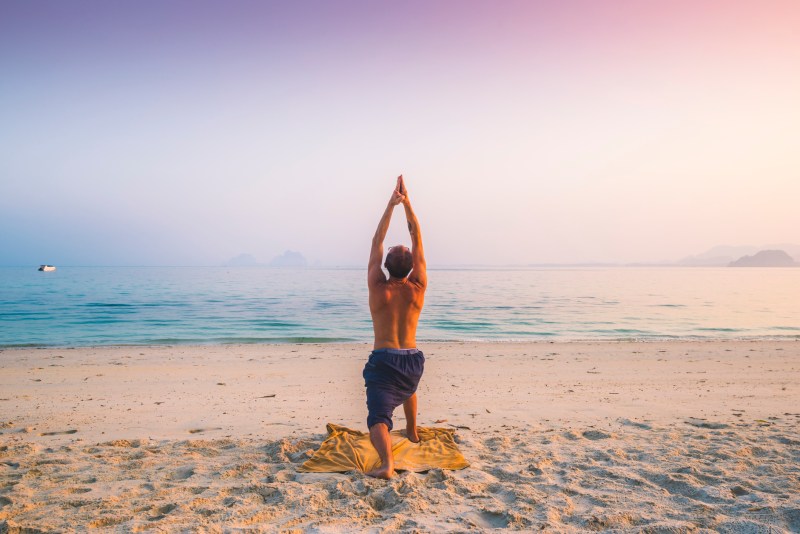Your breathing, an autonomous (involuntary) bodily function, is easy to forget. Your breath, however, is a constant every moment of your life. Your breath affects your mood, sleep quality, appetite, energy, heart health, even pH levels in the blood. Don’t believe it? Try an experiment: Sit up, back straight, take a deep draw in and let it slowly out of your nose.
Feel more chill? It’s not magic, it’s how you’re made. And it’s just a taste of what you can purposefully bring into your life with just a few minutes a day.
“We knew from our previous scientific studies that those practicing mind-body techniques tended to experience lower blood pressure, calmer brain activity, healthful emissions of nitric oxide in the body’s cells, and other physical and emotional benefits,” Dr. Herbert Benson wrote in Relaxation Revolution, a scientific study of how the mind can heal the body.
The following guide will show off some different techniques to practice deep breathing, what benefits these may elicit, and how you might incorporate these practices into your life. So, take a deep breath and dive in.
Shallow vs. Deep Breathing

We can blame advertising and endless promotion for perfect abs on our awful habit. Tightening the core, flexing your stomach muscles, and clenching your obliques are key to good strength. You just need to take a break sometimes to develop other important parts of your physique.
When you breathe with your belly squeezed, on inhale, your shoulders and entire torso stretch up. When you exhale, they drop. While this may feel like a full breath, it’s not. You’re mostly activating the tops of your lungs, which are incidentally the narrowest parts of these organs. Using less of your lungs deprives the body of oxygen necessary for full function upon inhaling and exhaling. As consequence, stale air then stays in the body instead of replenishing it with fresh air.
Research has shown that breathing exercises can have immediate effects. More importantly, they can train the body and immensely improve a number of health factors. Rapid breathing is controlled by the sympathetic nervous system — part of our “fight or flight” response activated by stress. By contrast, deep breathing stimulates the opposing parasympathetic system, easing hormone release and blood pressure and calming the body, heart, and mind. So breathe and give yourself a greater short- and long-term outlook.
How to Belly Breath

A correct breath engages your diaphragm, a huge muscle that wraps around the lungs. Reaching up to the diaphragm is your pelvic floor. These two muscles work together to help you fill and empty your entire lungs of air. To harness the diaphragm and the pelvic floor together, take a big belly breath all the way into your bottom. Next, exhale all the way by squeezing your lower abs and contracting your pelvic floor like you’re pinching your urethra. Notice how that muscle contraction pushes all of the air out of your lungs.
To practice your belly breath, you can do a number of fun training games. One of the easiest exercises just requires a stack of two or three books. Lie down on a floor or bed, and set the books on your belly. Slowly inhale, using your belly, trying to get the
Creating a Daily Habit

There are a number of ways to spend five to 10 minutes establishing a daily routine. Mindful or yogic practice in the morning is going to make you more clear-eyed and sharp during the day. You can sit in a comfortable position with your back straight and concentrate on your breath going in and out. You are typically encouraged to take air in through the nose and out through the mouth, but feel free to experiment. There are a number of ways to control and stimulate the breath.
Throughout the rest of your day, find time to consider your breath — maybe when you finish a task or just step away for a break. Shallow breathing (and possibly poor posture) is likely your norm, as it is with most people. If you do notice shallow, torso breaths, shift to belly breaths. With time, it will become your default.
After morning and midday, the time before bed also presents a perfect time to breathe better as slow, deep breathing will encourage your body to relax and drift into slumber.
Body and Mind

Every system in your body relies on oxygen. One of the benefits of yoga is the ability to regulate the sympathetic or involuntary nervous system, which controls breathing, heart rate, and blood pressure.
There’s no need for everyone to reach for that lofty goal, though. All it takes is a few minutes of conscious effort that can have enormous effects on your health. Effective breathing can not only give you a greater sense of mental clarity, it can also help your sleep, digestion, and immune response, and reduce stress. Focused meditation can bring you to a mindful place as you simply “watch” the breath enter and escape your body, and help you accept the present moment for what it is: The one true thing that has no past or future. So get those bellies moving to reconnect the body and the mind.
Editors' Recommendations
- Why strength training should be an essential part of your gym routine
- Your complete guide to medicine ball workouts
- 10 effective quad exercises you can do at home
- 8 reasons why rowing needs to be part of your workout routine
- Push-up training tips: Give your upper body strength a boost




